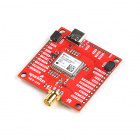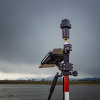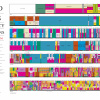We've got a lot of exciting tech packed into our positioning products, and we wanted to give you a deeper dive into some of the concepts. We recently released a RTK mosaic-x5 that receives a few different L-band frequencies, and we offer some L-band specific products like the RTK Facet L-Band. So what does all this talk about bands actually mean? Let's get into it.

In simple terms, GPS frequency bands are like radio channels that GPS devices and satellites use to communicate. They operate at different frequencies, similar to tuning your radio to different stations. L-band refers to a segment of the electromagnetic spectrum with frequencies ranging between 1 and 2 gigahertz (GHz). This portion of the spectrum has proven to be crucial in enabling a ton of communication technologies.

Certain characteristics about each frequency make them more suitable for specific applications.
| Specification | L-band | S-band | C-band | X-band | Ku-band | Ka-band |
| Frequency Range | 1-2 GHz | 2-4 GHz | 4-8 GHz | 8-12 GHz | 12-18 GHz | 26.5-40 GHz |
| Applications | Used in satellite communication, mobile communication (e.g., mobile satellite services), and navigation systems (e.g., GPS). | Commonly used in radar systems, satellite communication, and weather radar. | Satellite communication, weather radar, and some terrestrial microwave communication. | Radar systems, satellite communication, and some terrestrial microwave communication. | Satellite communication, broadcasting, and radar systems. | Satellite communication, terrestrial microwave communication, and some radar systems |
| Characteristics | L-band signals have good penetration through the Earth's atmosphere, making them suitable for both terrestrial and satellite communication. | S-band signals have relatively shorter wavelengths compared to L-band, allowing for better resolution in radar applications. | C-band is often used for long-distance communication due to its ability to penetrate through rain and other atmospheric conditions | X-band offers higher resolution in radar applications compared to lower frequency bands, making it suitable for various military and weather radar systems | Ku-band is often used for high-frequency satellite communication and broadcasting due to its ability to transmit large amounts of data | Ka-band is known for its high data transfer rates, making it suitable for broadband satellite communication. |
The L-band itself is divided into parts as well, which you've probably seen in our product descriptions and mention on video. The L-band is split into four sub bands centered at 1060 MHz, 1170 MHz, 1280 MHz and 1390 MHz, each with a bandwidth of 120 MHz. These bands are called L1, L2, L3 and L5.
L1: The L1 frequency is perhaps the most familiar, serving as the backbone for the GPS system that most consumer devices use. Operating at 1575.42 MHz, L1 carries both the standard positioning service for civilian use and an encrypted service for military applications. Its widespread adoption in consumer technology makes it a cornerstone of global navigation satellite systems, facilitating everything from navigation in cars to tracking in smartphones.
L2:Then there's L2, humming along at 1227.60 MHz. Initially dedicated to military use, L2 has been increasingly incorporated into civilian GPS applications, primarily because accessing signals from multiple frequencies can significantly improve accuracy. By comparing the signals received at L1 and L2, receivers can correct for ionospheric delay, enhancing the precision of location data.
L3: Operating at 1381.05 MHz, L3 plays a critical role in national security and emergency services. This frequency is utilized for nuclear detonation detection and plays a part in the United States Nuclear Detonation Detection System (USNDDS), which monitors for nuclear explosions worldwide. Its usage is more specialized and less prevalent in consumer applications compared to L1 and L2.
L5: Lastly, L5, clocking in at 1176.45 MHz, is designed with advanced safety-of-life transportation and mobile applications in mind. The L5 signal provides higher power, greater bandwidth, and improved resistance to interference, making it ideal for critical applications such as aviation navigation, where safety and precision are paramount. It's set to enhance the capabilities of GPS receivers further by offering an additional signal for improved accuracy, integrity, and availability.

The differentiation among these L-band frequencies is not arbitrary; it's a meticulously designed structure that caters to a broad spectrum of needs — from everyday navigation to high-stakes military and safety-critical applications.
Multiband receivers, capable of tapping into these diverse frequencies, unlock the potential for more accurate, reliable, and versatile positioning and timing solutions. They can selectively or simultaneously use signals from L1, L2, L3, and L5, optimizing performance across different conditions and applications. This multiband capability is a leap toward enhancing the robustness and efficiency of satellite-based navigation and communication systems, underpinning the seamless operation of technologies that define our modern world.
You'll see some of these multiband capabilities in our products, like our products that include the Septentrio mosaic-x5, which receives L1, L2 and L5 signals. You can also check out the Facet L-band and the GNSS Correction Data Receiver, which receives L-band corrections.
Thanks for coming along on this L-band journey with us! Next, we're going to take a look back in time to see why this frequency is the one we tune into for GPS. Stay tuned!
Have you utilized L-band signals in your work recently?















